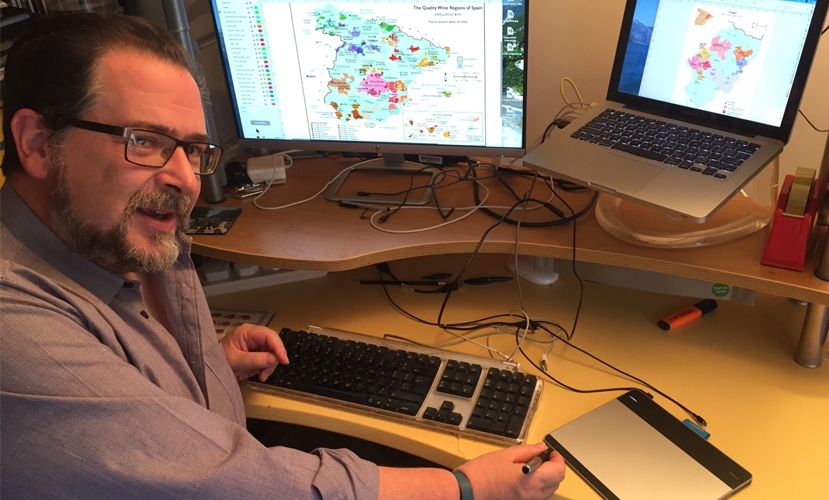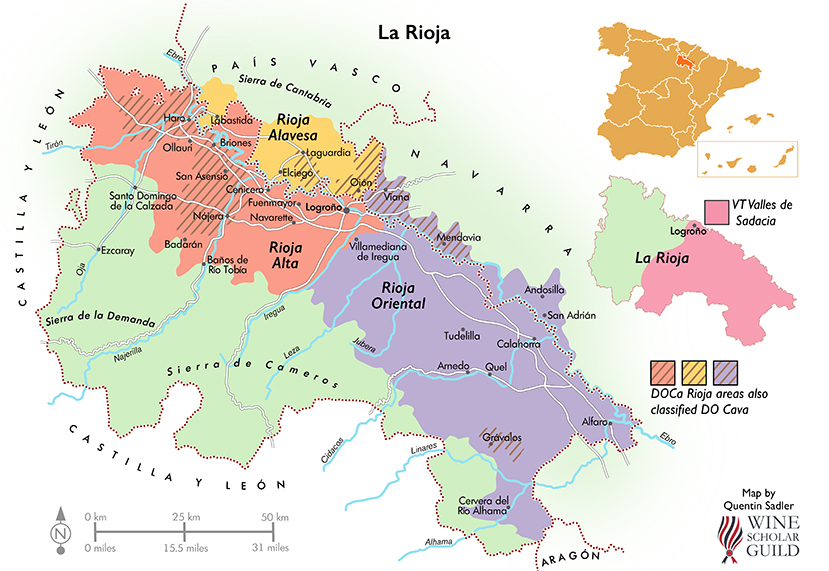BLOG
Mapping Spain with Quentin Sadler
Rick Fisher
Wine Education & Careers

In the search for a mapmaker for the Spanish Wine Scholar® program, I was somehow led to Quentin Sadler.
I didn’t think it possible to find someone with the same love and passion for Spain as I have, but I sure did in Quentin! It was obvious that our collaboration on this program was meant to be. His work is incredible and we both are committed to making this program the gold standard in Spanish wine education.
Quentin has more than 30 years in the wine trade and holds the Diploma from WSET. He is a passionate London-based wine educator, communicator, blogger, and mapmaker.
- Rick Fisher, Spanish Wine Scholar Program® Education Director
Q1. Quentin, you have been in the wine business for quite a while. What have been the most rewarding and/or exciting moments for you?
Ah, what a great question. So many things have happened to me in my 34 years involved in wine. My first time being in print as a wine writer was pretty special, as was being a guest of the Russian Orthodox monks on Mount Athos - which is a rare honour - to see the vineyards there.
However, right now creating a truly definitive set of Spanish wine maps for the Wine Scholar Guild is really exciting for me. It pulls all my interests together from my love of Spain, my love of wine and my desire to create. So, I am finding that very rewarding.
Q2. How long have you been designing wine maps? What type of research goes into creating an accurate wine map?
I have been creating maps for around 15 years now. Originally, they were pretty rudimentary and just for my own use, but I have become more ambitious and more skilled over time.
The research can be very difficult as almost no sources are consistent. Just making sure a river is in the right place can be really tricky and time consuming. As for ensuring the wine regions are correct, sometimes that drives me mad. I have to plot each wine region municipality by municipality, which can make me go a bit cross eyed at times. I guess the pain is worth it though!
Q3. I know you have a special place in your heart for Spain. Can you explain?
Ah, well I sort of grew up in Spain. Ever since I was born, in 1965, we have had a holiday home in Jávea/Xàbia, midway between Valencia and Alicante in the Communidad Valenciana. We spent every summer there and it is where all my happy childhood memories are. It is where I first drank beer and wine, too - in 1969!!
In fact, my father and brother both live out there, so even now I go there quite a lot, at least twice a year.
I love Spain and feel very Spanish even though I am not. I love the history, culture, countryside, food, people, and the wine. I have yet to find a Spanish city that does not excite me. Spain is the best place on earth for café culture, good food, great wine, and a wonderful atmosphere wherever you go.
Obviously, a great many countries make good and great wine, but I truly do think that Spain is the most exciting wine producing country in the world right now. What’s more, although Spain is famous for red wines, it is the whites that are especially thrilling because they are so unexpected.
Is there a more reliable white wine region right now than Rueda? Can any white wine be more thrilling than a good Txakoli de Guetaria? Are there any more intriguing white wines around than the Albillos of Castilla y León? Are there any more delicious rich white wines than the herbal and textured Garnacha Blancas of Terra Alta?
As for exciting reds, I keep finding them. Cool climate, high altitude Garnacha from Navarra. Chunky, vibrantly fruity Monastrell from Jumilla. Bobal with tamed, molten tannins from Valencia and the warming spicy blends from Montsant and Priorat - and much much more.
I just love the country and wherever I roam and however far I go I can always go back to Spain and find something new and wonderful whether it’s wine, food, culture or the landscape.
Q4. How are you finding the work of designing maps for the Spanish Wine Scholar program? What challenges have you faced along the way?
I am loving this project. It’s hard work and very demanding, but I feel that it is going to be a fine piece of work when it is finished.
The challenges are huge and very varied. Accuracy is hard because there is simply no agreement on what the truth is. Even the names of wine regions or the terms for the different classifications can vary, as, of course, can the languages used on labels.
Wine is always in flux, so things are always up in the air, with new regions coming along and old ones being promoted, and we want to show as accurate a snapshot as we can. We also want it to be as detailed as possible and yet to still be clear and really easy to read. I have developed a clean, crisp style that I think will work nicely and help our students rather than confuse them.

Sample DOCa Rioja map from the upcoming Spanish Wine Scholar manual (copyright Wine Scholar Guild and Quentin Sadler)
Q5. Is there anything else you would like us to know about your work?
I just hope this course will bring Spanish wine alive to loads more people and that my maps will help them to understand what makes Spanish wine tick and help them to discover its huge variety and excitement for themselves.
Rioja gets so much of the fame that, much as I love the wines of Rioja, I desperately want people to try all the other fabulous wines that Spain has to offer and hope that my maps will help them to roam through everything that Spain has to offer.
I truly believe that understanding wine is all about seeing the landscape and experiencing the wines and I hope my maps help with that.
For me it is a real labour of love and I hope that shows in the finished course.
Click HERE to discover all the detailed regional wine maps, extracted from the Spanish Wine Scholar® study manual. Now FREE for all!
